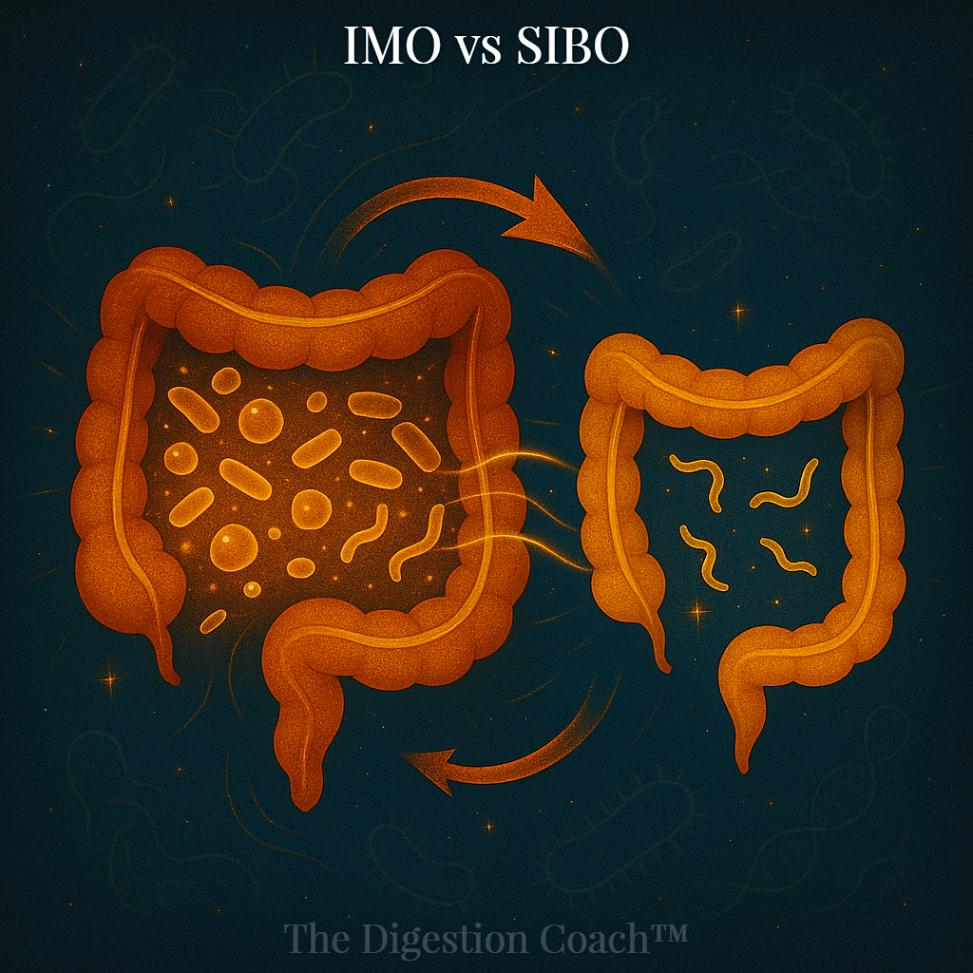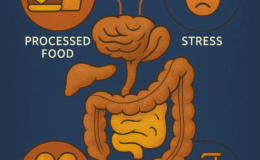If you’re dealing with bloating, constipation, or diarrhea, you might have heard of IMO (intestinal methanogen overgrowth) or SIBO (small intestinal bacterial overgrowth). Gut health issues like SIBO and IMO can disrupt your daily life, causing discomfort and affecting overall wellness. These gut health conditions can feel like a mystery, but understanding IMO vs SIBO can help you find answers and feel better. In this guide, we’ll break down what IMO and SIBO are, their similarities, their differences, and how to obtain the correct diagnosis and treatment. Let’s dive into the world of gut health!
Common Gut Health Issues: SIBO and IMO
Gut health issues can significantly impact your quality of life, and two common culprits are SIBO (small intestinal bacterial overgrowth) and IMO (intestinal methanogen overgrowth). These conditions often cause symptoms like bloating, diarrhea, or constipation, leaving many searching for answers. Understanding what SIBO and IMO are is the first step toward effective diagnosis and treatment.
What Are SIBO and IMO?
Before comparing IMO vs SIBO, let’s define them in simple terms.
- SIBO (Small Intestinal Bacterial Overgrowth): SIBO happens when too many bacteria grow in your small intestine, where only a few should live. These bacteria ferment food, producing gas that causes bloating and discomfort. Think of it like a crowded party in a quiet neighborhood—too many guests cause chaos!
- IMO (Intestinal Methanogen Overgrowth): IMO occurs when archaea (tiny microbes, not bacteria) overgrow in your small or large intestine. These archaea produce methane gas, which slows digestion and often causes constipation. Imagine archaea as a different kind of guest stirring up trouble in your gut.
Both conditions disrupt your gut health, but they involve different microbes and symptoms. Let’s explore how they’re similar and different.
Similarities Between IMO and SIBO
As a SIBO specialist and Digestion Coach, I know that IMO and SIBO have a lot in common, which is why they’re often confused. Here are the key ways they’re alike:
- Too Many Microbes in the Gut: Both involve an overgrowth of microbes where they don’t belong. In SIBO, bacteria crowd the small intestine. In IMO, archaea take over the small or large intestine. It’s like weeds (SIBO) or an invasive plant (IMO) taking over your garden.
- Shared Symptoms: Both cause bloating, abdominal pain, gas, and fatigue. These happen because microbes produce gas while digesting food, making your belly feel full or uncomfortable. Other symptoms include heartburn or even anxiety, as your gut affects your whole body. Did You Know? About 70% of people with irritable bowel syndrome (IBS) may have SIBO or IMO, with a 2022 study finding 68.1% of tested patients positive for these conditions.
- Diagnosed with Breath Tests: A breath test is used to analyze and diagnose both conditions. You drink a sugar solution (lactulose or glucose), and the test measures the gases produced by the gut microbes. SIBO shows high hydrogen gas, while IMO shows high methane gas. Sometimes, both gases are high if you have both.
- Linked to IBS: Both are tied to IBS, a common condition with ongoing gut issues. SIBO is often linked to diarrhea-type IBS (IBS-D), while IMO is more common in constipation-type IBS (IBS-C).
- Treated with Antibiotics or Natural Antimicrobials: Doctors use antibiotics to reduce microbial overgrowth. For SIBO, rifaximin is common. For IMO, a combo of rifaximin and neomycin or metronidazole is often needed. Diet changes or probiotics may also help restore gut balance.
SIBO symptoms, such as bloating, diarrhea, and abdominal pain, often overlap with other digestive disorders, such as fructose intolerance, making diagnosis tricky without proper testing.
Differences Between IMO and SIBO
While IMO and SIBO share similarities, their differences are crucial for accurate diagnosis and treatment. Here’s how they diverge:
- Type of Microbe:
- SIBO: Caused by bacteria (e.g., E. coli or Klebsiella) producing hydrogen or hydrogen sulfide gas.
- IMO: Caused by archaea (e.g., Methanobrevibacter smithii), a distinct microbe type producing methane gas.
Analogy: SIBO is like dogs barking in the wrong yard (bacteria). IMO is like birds creating a different disturbance (methane).
- Where They Happen:
- SIBO: Occurs in the small intestine, disrupting nutrient absorption.
- IMO: Can occur in the small or large intestine, as archaea thrive in both.
Example: SIBO is a traffic jam in one street (small intestine). IMO is city-wide gridlock (small or large intestine).
- Main Symptoms:
- SIBO: Often causes diarrhea due to hydrogen speeding up gut motility. Bloating and loose stools are common.
- IMO: Typically causes constipation, as methane slows digestion, leading to harder stools.
Quick Tip: Diarrhea? Suspect SIBO. Constipation? Consider IMO.
- Gas Produced:
- SIBO: Bacteria produce hydrogen (H2) or hydrogen sulfide (H2S). A breath test showing hydrogen ≥20 ppm within 90 minutes suggests SIBO (some studies propose >12 ppm for glucose tests, but this is not standard). H2S (≥3 ppm) requires specialized testing, available at select labs.
- IMO: Archaea produce methane (CH4). Methane ≥10 ppm at any time indicates IMO. (Thresholds may vary by lab.)
Fun Fact: Archaea in IMO “eat” hydrogen to produce methane, which can influence test results.
- Treatment Needs:
- SIBO: Often treated with rifaximin alone to target bacteria. An elemental diet may help in resistant cases by starving bacteria.
- IMO: Typically requires rifaximin plus neomycin or metronidazole, as archaea are harder to eradicate, though rifaximin alone may work for some. Elemental diets are also effective for severe cases.
Note: IMO treatment may involve more potent antibiotics, increasing potential side effects. Always consult a specialist to tailor therapy.
- Health Impacts:
- SIBO: May lead to nutrient deficiencies (e.g., B12, iron) as bacteria consume nutrients. Linked to diabetes or gut surgeries.
- IMO: Associated with slow gut motility and constipation, less likely to cause B12 deficiency, but still affects absorption.
The IMO vs SIBO comparison highlights key differences in microbes, location, gases, symptoms, testing, and treatment.
| Feature | SIBO | IMO |
|---|---|---|
| Microbe | Bacteria (e.g., E. coli) | Archaea (e.g., M. smithii) |
| Location | Small intestine | Small or large intestine |
| Main Gas | Hydrogen | Methane |
| Common Symptom | Diarrhea | Constipation |
| Breath Test | High hydrogen (≥20 ppm) | High methane (≥10 ppm) |
| Treatment | Rifaximin | Rifaximin + neomycin/metronidazole |
Why Understanding IMO vs SIBO Matters
Knowing the difference between IMO and SIBO helps you work with your doctor to get the right diagnosis and treatment. Bloating and diarrhea might point to SIBO, while constipation could suggest IMO. Since both can mimic IBS or other gut issues, a hydrogen and methane breath test is the best way to confirm what’s going on.
Pro Tip: Preparing for a breath test? Follow your doctor’s instructions, like eating a plain diet the day before, to ensure accurate results.
Want to learn more about SIBO? Check out my other SIBO blog posts:
Meet Orange County’s Leading SIBO Specialist: Dr. Marcus Ettinger
Struggling with bloating, gas, diarrhea, or constipation? If you suspect SIBO or IMO, you need a trusted gut health specialist. Meet Dr. Marcus Ettinger, Orange County’s premier SIBO specialist and The Digestion Coach™, with over 36 years of experience helping patients worldwide reverse their gut health issues.
Book a Consultation with Dr. Ettinger
Why Choose Dr. Ettinger?
Dr. Ettinger takes a root-cause approach, using advanced diagnostics and personalized protocols to treat SIBO and IMO effectively. His expertise covers:
- Methane- and Hydrogen-Dominant SIBO
- Constipation-Dominant (SIBO-C) and Diarrhea-Dominant (SIBO-D)
- Complex SIBO Cases: Including relapsing, post-infectious, or pediatric SIBO.
- Related Gut Issues: Expertise in H. pylori, candida, leaky gut, food sensitivities, and histamine intolerance.
With a focus on functional medicine, Dr. Ettinger provides compassionate, results-driven care locally in Orange County, nationally, or even abroad. His proven strategies address SIBO and IMO from cause to cure, ensuring lasting relief.
FAQs About IMO and SIBO
Can you have both SIBO and IMO?
Yes! Some people have high hydrogen and methane on breath tests, meaning both conditions are present. Treatment may need to target both.
How do I know if I need a breath test?
If you have ongoing bloating, diarrhea, constipation, or IBS-like symptoms, ask your doctor about a hydrogen and methane breath test.
Are SIBO and IMO curable?
Both can be treated, but they may recur. Antibiotics, diet changes, and lifestyle tweaks can manage symptoms and improve gut health.
Take Control of Your Gut Health Issues Today
Whether it’s SIBO, IMO, or both, understanding IMO vs SIBO is the first step to feeling better. Talk to a gut health specialist like Dr. Marcus Ettinger, get tested, and explore treatments that work for you. Your gut deserves some love!
Have questions about SIBO or IMO? Drop them in the comments below or contact a gut health specialist. Subscribe to our newsletter for more tips on improving your gut health!











Leave a Comment